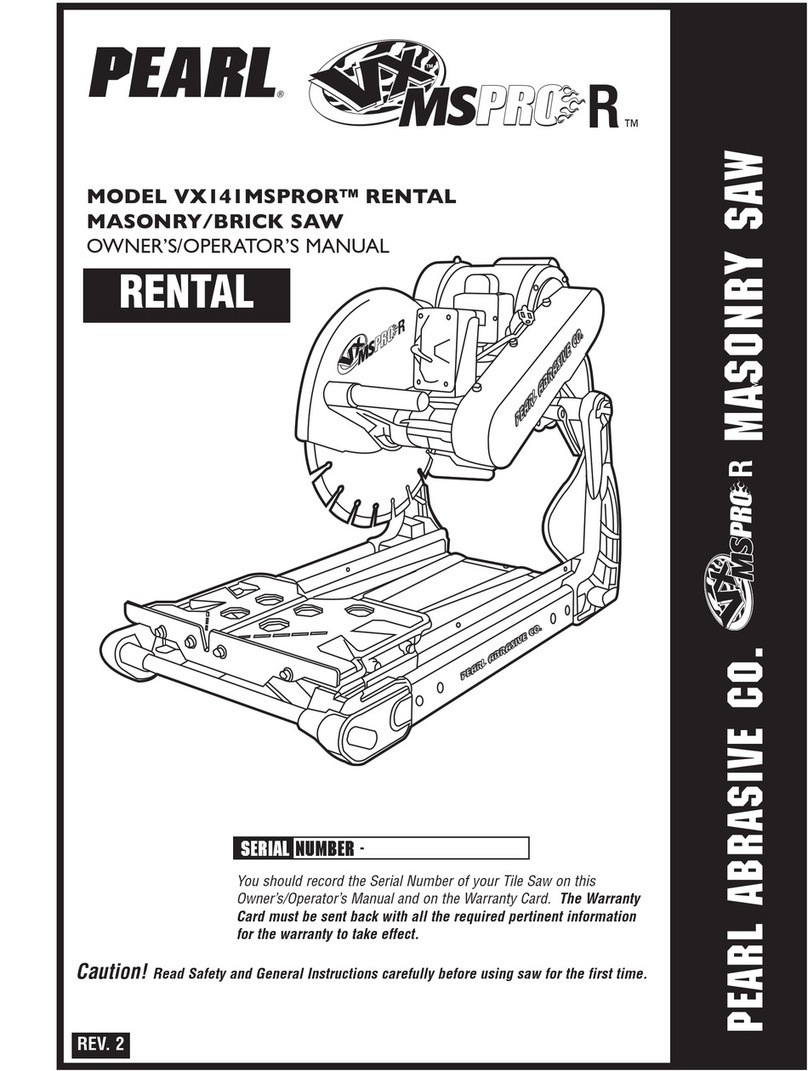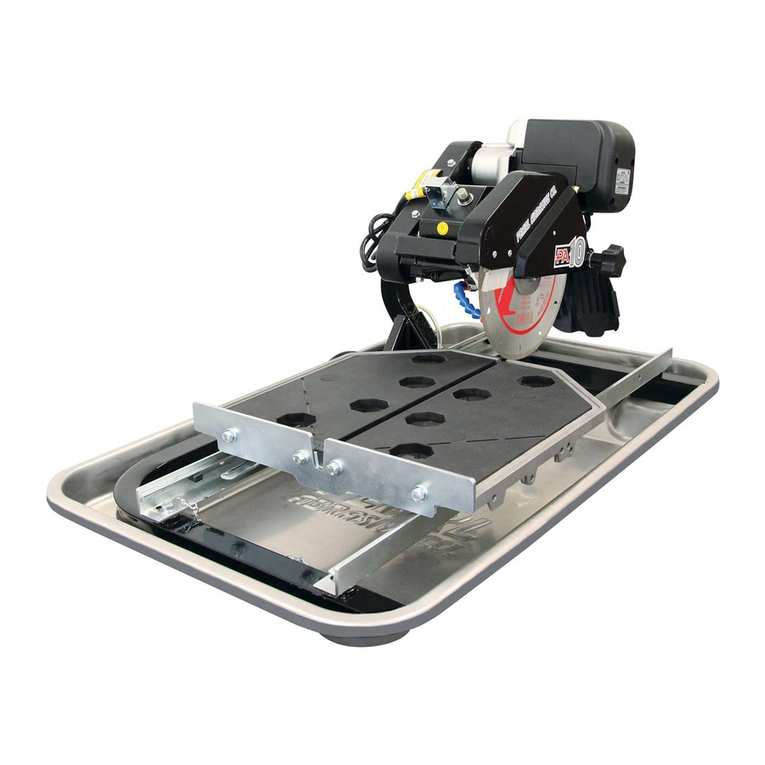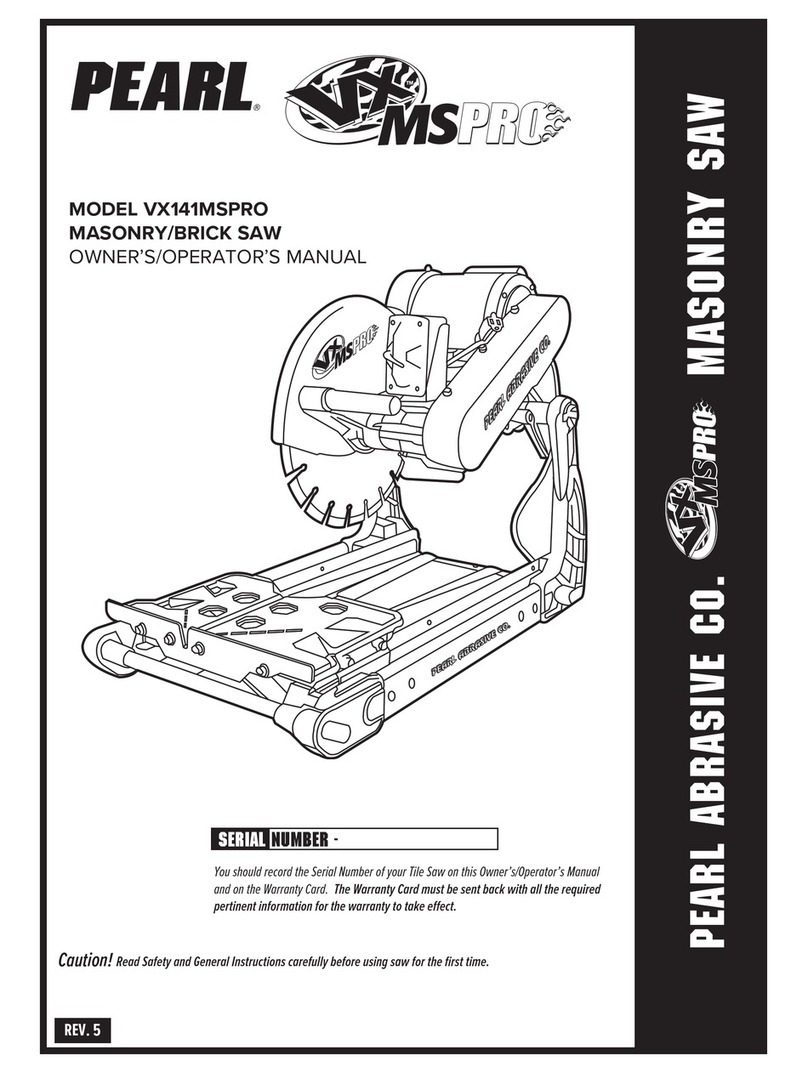
– 10 –
• Do not attempt to cut pieces too small to
safely hold down on the main table.
• Never use the side of the blade to cut or
grind with, only cut in a straight line.
• Keep all parts of your body away from the
blade and all other moving parts.
• Never touch or try to stop a moving blade
with your hand.
16. When cutting dry - always unplug the water
pump first. Never run the pump dry.
• Do not use a wet cutting blade for dry
cutting. Select the proper dry cutting
blade for your application.
• Never make long continuous cuts with dry
cutting blades. To avoid heat build up,
allow the blade to cool, remove the tile
and allow the blade to run freely for a few
minutes.
IMPORTANT - If there is any tendency for the
saw to tip or ove during certain operations,
such as when cutting large heavy tile; the saw
ust be securely fastened to a supporting
table.
17. Make certain all adjusting knobs or locks are
tight and engaged in their detents and that
movable parts not intended to move during
operation are securely locked before making a
cut. Be careful not to over tighten.
18. Before connecting the machine to a power
source check to see that the “On/Off” switch is
in the “off” position.
• Make sure the blade is not contacting
anything before connecting to a power
source and starting the motor.
• Know how to stop the machine quickly in
case of an emergency.
19. rounding Instructions
• In the event of a malfunction or
breakdown, grounding provides a path of
least resistance for electric current to
reduce the risk of electric shock. This tool
is equipped with an electric cord having
an equipment-grounding conductor and a
grounding plug. The plug must be
plugged into a matching outlet that is
properly installed and grounded in
accordance with all local codes and
ordinances.
• Do not modify the plug provided - if it will
not fit the outlet, have the proper outlet
installed by a qualified electrician.
• Improper connection of the equipment-
grounding conductor can result in a risk
of electric shock.
• Check with a qualified electrician or
service personnel if the grounding
instructions are not completely
understood, or if in doubt as to whether
the tool is properly grounded.
• Use only 3 wire extension cords that have
3 prong grounding plugs and 3 pole
receptacles that accept the tool’s plug.
Repair or replace damaged or worn cord immediately.
This tool is intended for use on a circuit that has an outlet
that looks like the one illustrated in Figure 6. The tool has
a grounding plug that looks like the plug illustrated in
Figure 6(A). A temporary adapter, which looks like the
adapter illustrated in Figure 6(B) and 6(C), may be used
to connect this plug to a 2 pole receptacle as shown in
Figure 6(B) if a properly grounded outlet is not available.
The temporary adapter should be used only until a
properly grounded outlet can be installed by a qualified
electrician. The green-colored rigid ear, lug, and the like,
extending from the adapter must be connected to a
permanent ground such as a properly grounded outlet
box.
Note: USE OF A TEMPORARY ADAPTER IS NOT
PERMITTED IN CANADA.
Additionally, water pump requires the use of a round
Fault Circuit Interrupter. Therefore, when using the water
pump receptacle, this tool must be plugged into a
properly installed round Fault Circuit Interrupter outlet.
See Figure 6(D). If a round Fault Circuit Interrupter
outlet is not available, Pearl Abrasive Co. has it available
as an accessory item. A plug-in round Fault Circuit
Interrupter may be plugged into a properly installed and
grounded 3-pole outlet. Refer to Figure 6(E).
20. Position of the Tile Saw
• To avoid the possibility of the appliance
plug or receptacle getting wet, position
tile saw to one side of a wall mounted
NOTE - Use of a Te porary Adapter is not per itted
in Canada.



































